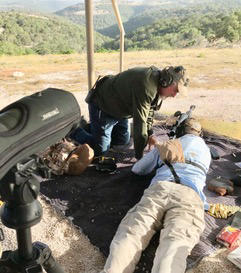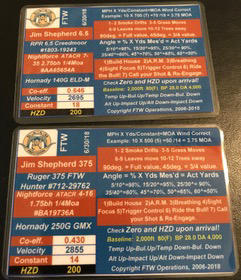When I’m trying to learn a new skill, whether it’s fly casting, shooting or whatever, there’s nothing quite so helpful to me as watching someone who knows what they’re doing.
Watching pro anglers effortlessly make accurate casts, practical shooting pros quickly draw a handgun and clean a plate rack or Kim Rhode mount a shotgun and powder clays isn’t just entertaining for me, it’s informative.
How they do what they do gives an insight into how these things should be done.
At that point, it’s up to you to take what you’ve seen and apply it
For me, that means long sessions of slow-speed repetitions imitating what I’ve seen them do. During that process I come up with an honest evaluation of my capabilities.
Kevin VanDam, KC Eusebio and Kim Rhode have nothing to worry about.
My recent trip to FTW Ranch in the Nueces River country outside Barksdale, Texas taught me about two types of shooting where I don’t have much experience: long range shooting and dangerous game hunting. It was an eye opening two-fer. And we’re only talking about the long range part here.
Having shot some long range, I didn’t imagine it would be the most difficult part.
First mistake.
Virtually all my long-range shooting has been with an experienced spotter. I jokingly called myself a “trigger monkey”. Now I know why they laughed.
Basic shooting skills are important in long-range shooting, but aiming accurately in 20-25MPH crosswinds at distances up to - and beyond- a mile is a blend of art-and science. Anything else is just pulling the trigger and hoping for the best.
It was a crazy steep learning curve.

FTW’s instructors patiently guided us through our initial confusion over windage/elevation changes. Quite a change from the “special operators” who left shortly before our arrival. |
The ballistics calculations necessary were far beyond my limited experience and “Kentucky windage” doesn’t help if you can’t see your target without extreme magnification.
Our instructors used their rangefinders to give accurate distances. And we had built custom range cards they’d built for our assigned guns/optics before we arrived. Between their accurately calling distance and our using their range cards, we made hits in excess of 1000 yards- 300 yards further than the cards. The longer distances helped us quickly realize just how complicated figuring on the fly could be.
At that point we headed to the classroom where Kestrel ballistics calculators were handed out. The idea was to provide us tools to enable us to make those same long distance shots - without range cards. Great if you had an idea how to run a Kestrel.
For me, an already steep learning curve went vertical. Rangefinders I understood. But ballistic calculations might as well have been alien technology. Gradually it started to make sense -and I eventually came up with the same classroom answers as the far more experienced shooters in my group.

The all-important range cards carried the information necessary to know the adjustments to make -out to 700 yards. It got harder after that. Jim Shepherd/OWDN photo |
But it wasn’t easy. Leading me to the best advice I can give you when it comes to long distance shooting. Do not dash out and get one of those amazing units thinking you just hold it up to the wind and it will immediately tells you “aim right there.”
It’s considerably more complicated than a rangefinder.
Those I use for everything from measuring walls at home to checking distances from hunting blinds. But they’re purpose specific. Distance measurement. They establishing the outer limits of my comfortable shooting zones when hunting. As the instructors at FTW put it, “you know you own all the real estate between you and that confidence marker.” Beyond that marker, I simply don’t shoot.
I’m less strict when target shooting, because only my pride suffers if I miss.
But my goal is always the same: to hit the target with a first shot, not to “walk” in rounds like an artillery barrage.
Lying atop a breezy Texas ridge line with targets from 100 to 2500 yards away (not visible to the naked eye) brought me out of my comfort zone- fast. And my Kestrel unit (a 5700 model) required considerably more data points to calculate accurate shots -than I could punch in on the fly. At that point I realized the value of building my rifle’s data set during my classroom sessions. All that was needed was the atmospheric info the Kestrel measures in real time.
The data, along with FTW’s quality training (and coaching) on the technologies and information needed to shoot at those distances allowed me to concentrate on the basics of shooting mechanics.
And my hits started to come more predictably at increasingly longer distances. To the point I made three hits on targets at 1765 yards - in a wind occasionally gusting to 20 miles per hour. And I suddenly realized I was hitting man-sized targets at more than a mile (1765 yards is 5,295 feet- just beyond the goal I’d hoped to reach).
Simply put, today’s technology is awesome - and there’s never been a better time to consider taking up long-range shooting.
Ruger provided their Precision Rifles chambered in 6.5 Creedmoor -and they were more than capable of that prodigious distance (now I know why real long-range shooters love that caliber). Coupled with Kestrel’s 5700 Ballistics Weather Meter and a reliable rangefinder (reliable means “mounted on a sturdy surveryor’s tripod, not a $29 wonderpod”) and a Nightforce ATACR 7-35 riflescope, I had a rig that enabled me to hit targets I couldn’t see with my naked eye -yet could comfortably carry inside or strapped to a day pack.
Granted, this wasn’t an inexpensive kit, but the price of everything is still significantly lower than the price of a precision long-distance rifle not 10 years ago - without optics, rangefinders or ballistic calculators
And today’s technology means you need fewer shots to get rounds on target. Ammunition, unfortunately, hasn’t gotten more affordable, especially in the calibers necessary for long-distance shooting.
One thing hasn’t changed. I’m still not going to take a long distance shot at an animal.
There’s a big difference between target shooting and hunting. But that’s a subject for another time.
— Jim Shepherd
Editor’s Note: Learn more about FTW Ranch in this week’s edition of The Outfitters Wire
